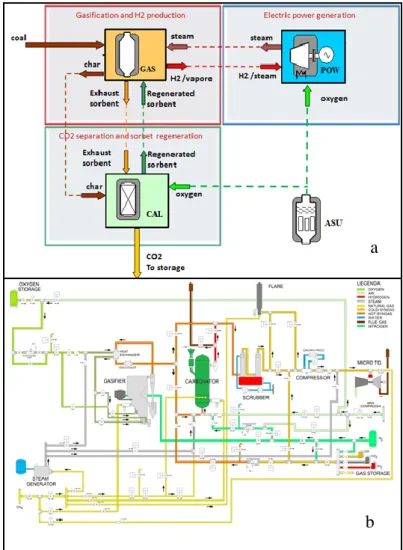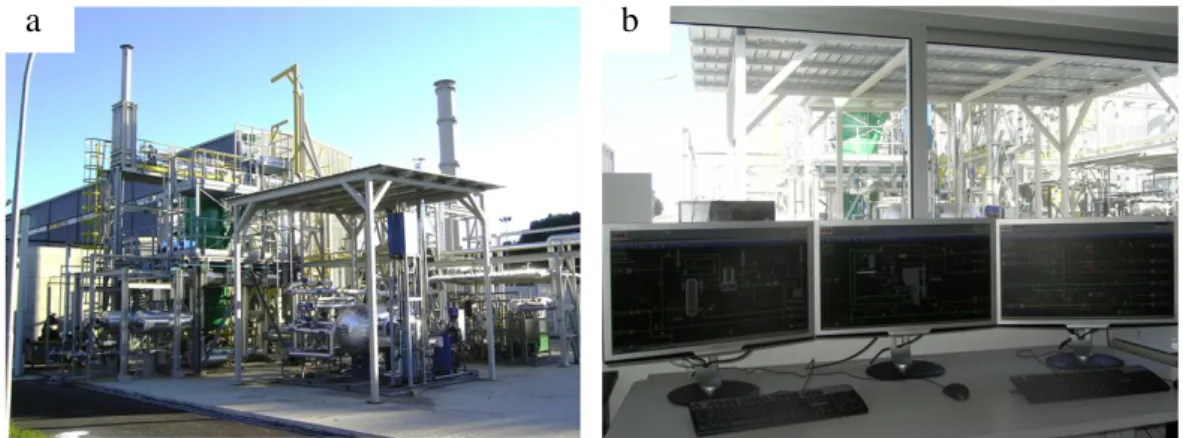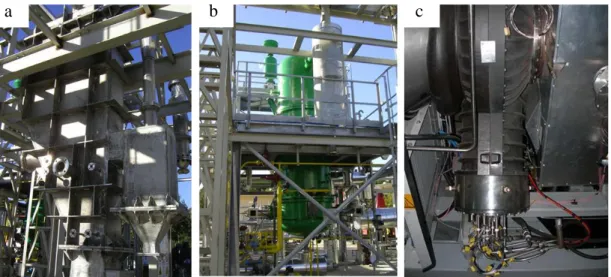PROCEEDINGS OF ECOS 2012 - THE 25TH INTERNATIONAL CONFERENCE ON
EFFICIENCY, COST, OPTIMIZATION, SIMULATION AND ENVIRONMENTAL IMPACT OF ENERGY SYSTEMS JUNE 26-29, 2012, PERUGIA, ITALY
222-1
Implementation of a CCS technology: the
ZECOMIX experimental platform
Calabrò Antonioa, Cassani Stefanoa, Pagliari Leandroa Stendardo Stefanoa
a ENEA, Italian National Agency for New Technologies, Energy, and the Sustainable Economic
Development Via Anguillarese, 301, S. Maria di Galeria, 00123, Rome, Italy
Abstract:
One of the key challenges for the implementation of CO2 Capture and Storage (CCS) is the reduction of the CO2 capture costs derived by their applications in actual power plants. The research of new technologies based on more efficient materials and more efficient design for integration of CO2 capture technologies in power cycles, is a promising way to ensure, in the medium term, costs and energy performances comparable to the actual power plant without CCS. ZECOMIX experimental platform represents the ENEA proposal for this challenge and it can be count among the Research Infrastructures more innovative in Europe. The aim of this work is to present the first results of commissioning plant tests. Therefore this work is focused on the planning of future experimental activities in order to demonstrate the feasibility of the high temperature solid sorbent CO2 sorption process, applied to a syngas derived from coal gasification.
Keywords:
Keywords: Ca-based sorbent, carbon capture, solid chemical looping, gasification.
1. Introduction
In July 2005 the activities of the project ZECOMIX (Zero Emission Coal Mixed Technology) started officially, within the framework of a program funded by the Italian University and Research Minister. The main aim of the project is to demonstrate, through a series of modelling and experimental activities, the feasibility of a new innovative process for production of electricity and hydrogen "zero emission" by coal. In the ZECOMIX project different processes (e.g. coal gasification, clean-up of syngas, capture and sequestration of CO2, combustion of hydrogen in gas turbine) have been coupled. The integration of these processes is the key factor to achieve higher cycle performance and optimization (fig.1) of the platform at hand. Preliminary studies on high temperature decarbonization syngas [1-3] and thermodynamic H2/O2 cycle [4,5] as led us to propose ZECOMIX cycle with a net electrical efficiency close to 50% [6]. The analysis was subsequently refined with the cooperation of major Italian Universities and Research Institutes, and the results have fully confirmed the encouraging prospects that the cycle had announced: at least ten-point performance higher than a current post-combustion capture technology coal plant [4,5]. The design and realization of a complex experimental platform to test new process for CO2 capture and hydrogen production was certainly the more challenging tasks from a technical and financial point of view. A large numbers of advanced research issues is related to the proposed platform (coal hydro-gasification, simultaneous high temperature CO2 and H2S capture with solid sorbents, hydrogen/steam fuelled micro-turbine). Preliminary studies have permitted us the commencement of several research lines in the fields of advanced system modelling [2,6] for testing coal gasification, and the study of materials for CO2 capturing [1-2]. On the other hand the great know-how gained with years allows us to enter with a leading role in the most important European scientific organizations, in order to coordinate the research on CCS technologies considered the most promising option for sustainable use of fossil fuels in the near future. The experimental ZECOMIX pilot plant has been designed and constructed to test each single unit integrated in the platform. It is an advanced and flexible facility particularly oriented to the experimental
222-2
investigation and the developing of process and component modeling. The plant has been presented in an international framework (e.g. CSLF, ZEP, ECCSEL, EERA) and consistent with advanced technological initiatives of the European and worldwide scientific community. Moreover ZECOMIX plant has been evaluated and inserted in the first Italian Roadmap towards the Large research Facilities conceived by the Ministry of Research.
2. Conceptual description of the ZECOMIX platform
Details of the ZECOMIX concept are presented in [6] whereas alternative configurations are proposed in [4,5] . In Fig 1(a) we have reported the main areas of the platform and how they are connected each other; in Fig 1(b) the layout of the platform constructed is showed. This work highlights our efforts in the realisation of the plant layout showed in Fig 1(b). The plant (see Fig 2(a)) can be broken into :
Unit based on a 50 kg/h coal fluidised bed;
Syngas decarbonising reactor. It has been conceived as a fluidised bed and designed in order to decarbonise 100 Nm3/h of coal syngas leaving the gasifier or a gaseous mixture produced by means adequate cylinders;
100 kWe micro-turbine modified to accommodate a mixture of H2 and H2O.
Fig. 1. (a) Simplified schematic of the ZECOMIX concept; (b) Layout of the ZECOMIX platform.
A number of devices are installed to further treat the syngas (e.g. scrubbing, drying and compression) to make it suitable as fuel for the micro-turbine. Moreover a steam generator has been
b a
222-3
envisaged for operating the gasifier, the carbonator and the micro-turbine as well. The plant has been designed to test several experimental configurations:
Gasification test: the yielded syngas is diverted directly to the scrubbing device and then to the flare stack;
Carbonator test: the syngas is produced by mixing pure gases leaving bottles. This test allows us to investigate the decarbonising process over a number of syngases or flue gases; the inlet temperature of the syngas could be set up to 600 °C by means an adequate electric heater;
Micro-turbine test: in this test the turbine is fuelled with the syngas produced at the mixing unit; Base-case test: such a test is carried out with the syngas produced by means of the gasifier and
driven to the carbonator. Having completed the decarbonising process the syngas undergoes a scrubbing process and fed the micro-turbine or burnt in the flare stack. When the micro-turbine runs the syngas is compressed up to 6 bar by means of a compressing device and an amount of water steam is injected into the micro-turbine’s combustion chamber to moderate operating temperature. Such a device has been already tested by the Italian company “Ansaldo Ricerche” retrofitting an existing micro-turbine named Turbec T100;
Regeneration test: in this configuration the carbonator operates in regeneration mode firing by a number of adequate burners placed at the bottom of the reaction chamber to heat the sorbent up to the regeneration temperature.
The layout of experimental configuration and the control of the whole plant is carried on by a particular Distributed Control System (DSC) interfaced software through several synoptic schemes with regard to the plant configuration (Fig 2(b)).
Fig. 2. (a) Picture of the ZECOMIX platform; (b) Control station of the platform.
3. General description of the platform main components.
The detailed design of the plant started in early 2007 and it was realized with the help of Ansaldo Energy, and the first supply contracts were launched in April 2008. Civil infrastructures are composed of plant foundations, storage for solid material (dolomite, catalyst and coal), security bunker for H2 and CO gas cylinders, platforms of CO2, N2 and O2 gas tanks, and the basement of gas mixing station. Moreover, a control room building has been realized which includes the electrical cabinets of main equipments and the DCS. Simultaneously to the progress of civil works, the order of main equipments of the plant were carried out: carbonation reactor, fluidized bed gasifier, steam generator, syngas compressor, gas pre-heaters, gas clean up scrubber, flare stack, and, a micro-turbine adapted to high content hydrogen syngas.
Gasifier: Hydrogasification reactor as presented in [6] operates at pressure up to 60 bar,
incompatible with the project design atmospheric pressure; thus, it has been replaced by an oxygen/steam atmospheric gasifier, more robust and flexible than hydro-gasification reactor (see Fig 3(a)). The coal gasifier is a fluidized bubbling bed reactor designed in collaboration with
222-4
University of L’Aquila and Germanà&Co. Engineering. The coal feed system has been design in order to feed a nominal load of 50 kg/h of coal. The system is formed by a 2 m3 coal silo, which permits a stationary operation up to 36 hours, and two worm drives: a dosage worm drive in order to control the coal mass flow, and a second one to introduce mechanically the coal to the interior of gasifier. Steam and oxygen are feed on different points of the reactor, in order to control the solids hydrodynamics, and the reaction rate all over the reactor. Dolomite is added to the coal enhancing the fluidization, controlling temperature and capturing the H2S formed in the coal gasification. A syngas composed of H2, CO, CO2 and steam at temperature of 800°C is obtained. This syngas is sent to a regenerative heat exchanger reducing its temperature around 600°C. After this point can be introduced into the carbonation reactor, or can be clean-up in a scrubber, after a second cooling step to 350°C. Methane is mixed with the yielded syngas in order to emulate syngas composition of a syngas leaving hydro-gasification reactor. Moreover water is injected into this gaseous mixture in order to carry on steam methane reforming and CO-shift reactions
Carbonator: The carbonation reactor is a cylinder with 1 m diameter and 4.5 m height cylindrical
chamber (Fig. 3(b)). Reactor wall have 30 cm thickness and two layers refractory enclosure. At the bottom of the reactor there are two burners in order to calcine the sorbent in the regeneration phase at 900 °C. The distributor gas plate is situated above the burners and realized as a series of tubes placed perpendicularly to the orifices in order to broke the gas jets producing a quasi-homogenous velocity field. Moreover, this design allows us to reduce the attrition of nozzles and particles, and prevent the clogging of the particles in the orifice. The fluidized bed reactor is loaded with Ni-based catalyst, necessary for the steam methane reforming, and Ca-based sorbent in order to capture CO2. The addition of the sorbents serves to decarbonize the flue gas and to enhanced the steam methane reforming. This process is called Sorption Enhanced-Steam Methane Reforming and allows us to obtain a very high hydrogen content syngas, improving the methane conversion at relatively low temperatures (550-600°C). When the solid sorbent reaches at its ultimate conversion it is sent back to the regeneration step. Regeneration is done by means of oxy-combustion of methane in order to calcine the spent sorbent. High-concentrated CO2 stream is released and sent to final disposal. Subsequently, a cooling process is accomplished in order to return to initial carbonation condition starting another CO2 capture cycle.
Fig. 3. (a) Fluidised bed gasifier; (b) Carbonator; (c) Turbec T100 micro-turbine with the modified burner.
Micro-turbine and syngas scrubbing unit: The power generation is produced by means a
micro-turbine adapted to high content hydrogen syngas (Fig. 3(c)). Original micro-turbine is a Turbec T100, with 100 kWe of power output, retrofitting with a hydrogen burner ARI100T2 developed by Ansaldo Energy. Flue gas in the turbine outlet are mainly nitrogen and steam, achieving the “ carbon zero
222-5
emission” scope of the cycle. Micro-turbine is very sensible to the impurities. Then syngas scrubbing unit is fitted upstream the micro-turbine. Therefore, the scrubber is able to treat 400 Nm3/h in three stages: a Venturi scrubber, a spray tower wet scrubber, and a packed tower wet scrubber. The outlet particle diameter is lower than 1 m. The flare stack has been designed to the correct combustion of syngas from carbonator reactor or gasifier.
Steam generator: The steam generator have 200kWt power output, and it is provided with an
accumulator which permits a high flexibility mass flow production as a function of the configuration tests. It is possible to obtain three different mass flows at different pressure for every equipment: 30 kg/h at 1 atm for the coal gasification, 90 kg/h at 1 atm to the carbonatator, and 60 kg/h at 6 bar to the micro-turbine.
Syngas compressor: The syngas compressor has three intercool centrifugal stages in order to
maintain hydrogen under 130°C and water is drained. Then hydrogen stream is pre-heated and mixed with steam to the turbine conditions.
Heaters: Three heaters are installed in the platform. An oxygen heater has been fitted in order to
prevent condensation of water in the oxygen/steam mix. A nitrogen heater is needed to control the temperature in the heating/cooling processes in carbonation reactor between carbonation/calcination reactions. A heater of the syngas entering the carbonator is installed. Such a component is needed when synthetic gas is produced in the mixing station and send to the carbonator. In this case the syngas has to be heated from environmental temperature up to the carbonation temperature (600 °C).
The platform is being commissioning. Several tests has been carried out in order to prove DCS system, steam generator, hydrogen compressor, pre-heater and flare. The main objectives which have been accomplished are mainly related to coal gasification, high temperature CO2 capture by means of solid sorbents, fluidynamics of bubbling bed, combustion of hydrogen.
4. Future activities in the framework of the ZECOMIX project
In order to supply the experimental platform with a number of solid fuels (e.g. biomass and a blend of coal) a feeding system as flexible as possible is envisaged. Such a technological option will permit us to study the performances of the hydrogen production from solid fuels by varying the ratio of the different blends. Particularly the co-gasification of coal and biomass could be experienced and the main parameters affecting such a process will be studied. Such an experimental investigation will give information on how to mix coal and biomass and how the quality of the feedstock affects the production of electricity from hydrogen. Implementation of new sensors and probes (thermocouples and flux-meters) are envisaged. This improvement will permit us to increase the potential of the acquisition system and then the remote control of the process at hand with on-line monitoring and dynamic measurement. Particularly during the warm up of decarbonisation reactor the control of the refractory temperature is needed in order to know the evolution of the temperature profile into the refractory wall of the reactor and the characteristic time for heating up the reactor. In order to manage the energetic system at hand in an economically viable way, optimization of hydrogen and electricity production should be taken into account. These outputs of the experimental platform strongly depend on the correct blend of both feedstock and energy inputs (e.g quality and quantity of the solid fuel to be gasified and heat demand of calciner for sorbent regeneration as well). There is a lack of dependable economic and operative parameters, due to the intrinsic novelty of the proposed process. A valuable tool for addressing such a problem could be modeling each single main component (gasifier, carbonator, micro-turbine) to simulate and optimize ZECOMIX system. When thermo-economic constraints are included the optimization problem will increase significantly. Moreover if the number of variables governing the hydrogen and power production is relatively low an adequate and accurate DoE (design of experiment) is suggested as a valuable tool to determine how the main parameters affect the electricity production. Finally, the activities scheduled for the power unit at hand have been proposed in order to test the
222-6
hydrogen combustion technology at different scale levels and grades of integration with the whole experimental platform. In particular a dynamic model of the micro-turbine has been developed and integrated in a commercial power plant simulator. Such a model is a valuable tool for the simulation of a the micro-turbine in a number of operative conditions. Numerical simulation are needed to estimate the dynamic behavior of the power unit when the fuel supply switches from natural gas to hydrogen during full and half load as well. The experimental programmed activities have been enthusiastically welcomed by a number of European projects and research alliances to promote the co-operation between researchers. ZECOMIX project is involved in the ECCSEL initiative in the framework of CCS research facilities to share knowledge through network of researchers with the common interest to improve the assessment methodology for decarbonised energy production. Moreover the platform is involved in the EERA sub-programme for developing a methodology and comparing process performances in the field of CO2 capture.A complete schedule of activities has been planned are:
1. hot tests on carbonator in order to study heat transfer in the gas-particle-wall system and start-up procedure. Modeling activities are planned to predict the thermal behavior of the carbonator reactor. Start-up of H2 micro-turbine will be performed as well.
2. tests of SE-SMR reactor fed with synthetic syngas from cylinders. Performance of CO2 capture sorbents and catalyst. Study of instabilities in the process between calcination and carbonation phase. Integration with micro-turbine. Optimizing of operational conditions.
3. carbonation/calcination cycling with gasification integration. Studies of influence of gasification on flue gas composition. Effect of gasification on hydrogen production. Optimization of the process. Study of loss efficiency due to clean-up of gases.
Acknowledgment
The authors are grateful to Prof. Pier Ugo Foscolo and Prof. Antonino Germanà, of University of L’Aquila, for carbonator and gasifier design, and SO.IM.I. company for constructing the experimental platform.
References
[1] Stendardo S., Calabrò A., Experiments on CaO–CaCO3 loop for high temperature CO2 capture. ENEA Technical Report 2008 No.: EHE08039 TER-ENEIMP.
[2] Stendardo S., Foscolo P.U., Carbon dioxide capture with dolomite: A model for gas–solid reaction within the grains of a particulate sorbent. Chem Eng Science 2009;64:2343-2352. [3] Stendardo S., Di Felice L., Gallucci K., Foscolo P.U., CO2 capture with calcined dolomite: the
effect of sorbent particle size. Biomass Conv and Biorefinery 2011;1(3):149-161.
[4] Galeno G., Spazzafumo G., ZECOMIX: Performance of alternative layouts. International Journal of Hydrogen Energy 2010;35:9845-9850.
[5] Romano MC, Lozza G. 2010. Long-term coal gasification-based power plants with near-zero emissions. Part A: Zecomix cycle. Int Journal of Greenhouse Gas Control 2010;4:459-468. [6] Calabrò A., Deiana P., Fiorini P., Girardi G., Stendardo S., Possible optimal configurations for
the ZECOMIX high efficiency zero emission hydrogen and power plant. Energy 2008;33:952-962.


